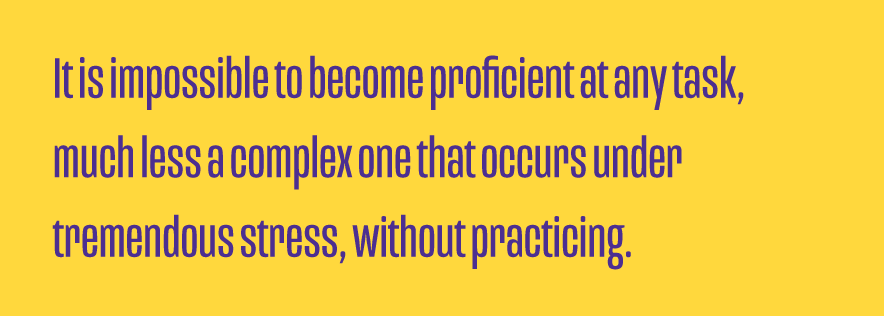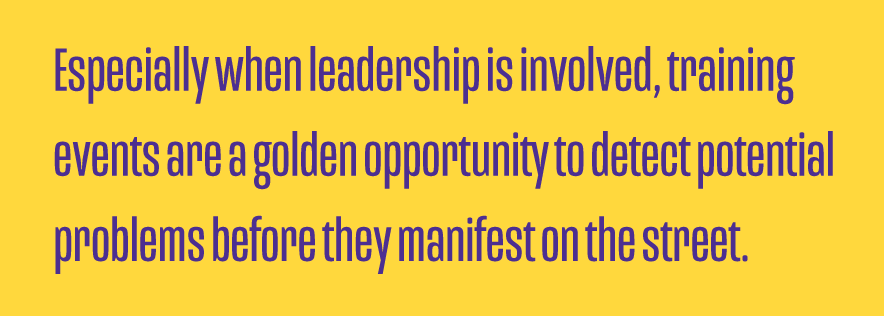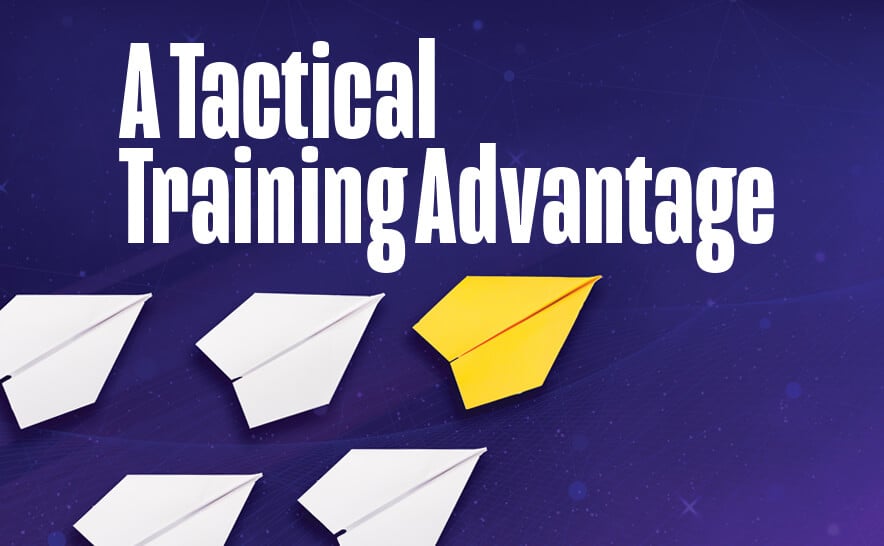Leveraging Tactical Training as a Leadership Advantage
Use-of-force performance is one of the great social issues of our time. The current focus is on police officers. However, it is a virtual certainty that this issue will eventually impact the private security industry as well. The liability is certainly there. Every security company is only one bad video or viral social media post away from a public relations disaster.
There are many issues to unpack with respect to use-of-force performance. One of the most significant—and ironically one of the least talked about—is the fact that industry standard training and qualification methods do a poor job of preparing people to use tactical skills in the real world.
 Virtually all vocational training structures, including those for security and law enforcement, are based on the assumption that important, job-related skills will be performed with some frequency in the workplace. Training provides an introduction and can develop an initial, basic level of performance. Skillful performance and experience are then developed on the job, usually under the watchful eye of experienced coworkers or assigned mentors. Documentation of the training and testing provide liability protection for employers and supervisors.
Virtually all vocational training structures, including those for security and law enforcement, are based on the assumption that important, job-related skills will be performed with some frequency in the workplace. Training provides an introduction and can develop an initial, basic level of performance. Skillful performance and experience are then developed on the job, usually under the watchful eye of experienced coworkers or assigned mentors. Documentation of the training and testing provide liability protection for employers and supervisors.
With respect to use of force, especially deadly force with firearms, however, this structure fails to deliver adequate results. The first time that a police officer or security officer uses his or her weapon on duty is likely to be the only time this event occurs during that individual’s career. For most, it will never happen. Unfortunately, this first-time event has the potential to be a pivotal moment, not just in the officer’s life, but indeed for the security company, the community, and perhaps even the world. There are no second chances to get it right.
It is impossible to become proficient at any task, much less a complex one that occurs under tremendous stress, without practicing. Therefore, use of force and tactical skills cannot be attained on the job. It is impossible. There simply is no opportunity to repeatedly perform them. To develop competence, these skills must be developed, and each officer’s performance ability validated, solely through the training and qualification process.
After standing up several security forces in the U.S. Navy and dealing with these same challenges repeatedly, the author became fully invested in finding effective solutions. Through more than 20 years of research, he can now identify two fundamental issues that negatively impact the preparation of armed professionals for use of force: Training delivery methods are poorly aligned with how the human brain learns, and methods of firearms qualification are mostly unrelated to real-world performance needs.
These two issues are important. They must be addressed before systemic use-of-force performance can be improved. Yet they are also not the only structural considerations in play. Another critical one is the separation of leadership and administration from firearms and tactical skills training. This generally occurs for logistical reasons; however, it robs leaders of an extraordinary tool for effective armed workforce management.
Most specialized skills and certifications carry some sort of initial training requirement followed by a periodic requirement for training or qualification. Both are normally mandated by some combination of regulation and policy.
When it comes to firearms training, the vast majority of the available resources and time are dedicated to preparing for, running, and passing the qualification test. Meanwhile, leaders and administrators (often back in the office) are typically only interested in three key performance indicators from the event: Did everyone qualify? Was anyone injured? Was anything broken or lost?
To be fair, why would there be high-level interest in any other metric? Those three issues cover everything that tends to matter for the security company. Liability and compliance have been addressed. Undue expenses have been avoided. Qualified security officers can go work billable hours. The company can make money. Good documentation also provides protection to the company and the company’s leadership should anything go wrong.
Implementing more rigorous standards necessarily requires more training and results in higher rates of failure. This creates inefficiency in the onboarding, training, and compliance processes, as well as a requirement for more training hours—and all to improve the performance of skills that may never be used on the job.
Costs matter. Extra expenditures on training that substantially exceeds the statutory minimums eat into profits and make a company’s bid less competitive. When the training is for skills that are unlikely to ever be used on the job, justification for resources rapidly becomes a challenge. The simple truth is that security managers have little incentive to push for anything more than the minimum that is necessary to legally put security officers on post.

This state of affairs is unfortunate, and not just because it negatively impacts the skill and performance ability of security forces. It also pushes leadership away from participating in firearms and tactical training. When training and qualification occur infrequently in predominantly high-resource settings and involve little more than performance of a rote shooting test, why would leadership be involved? There is nothing much of value to witness, only empirical scores and documentation to gather and track.
Not only does a lack of effective training negatively impact performance and officer survival, the lack of involvement this structure creates also deprives leaders and administrators of access to a powerful set of diagnostic tools and corrective opportunities. Without them, leaders are flying blind. Applied correctly, these can pay huge dividends towards both preventing performance issues in the field and ultimately reducing the organization’s liability.
As a force protection officer onboard a U.S. Navy warship, the author managed the ship’s security force while also serving as one of the ship’s small arms instructors. During deployment, one of the sailors had a negligent discharge while conducting counter-narcotics operations. The totality of the circumstances surrounding the event was particularly egregious. The sailor displayed a serious lack of judgment, not a lack of knowledge or skill, nor a momentary lapse in attention. After evaluation, the author was directed by the commander to attempt to retrain and requalify the sailor for firearms use.
During multiple dryfire training sessions over a period of days, the sailor continued to display a consistent lack of attention to detail and ongoing poor judgment. He also displayed either an unwillingness or inability to handle weapons with the care they were due.
The sailor was more than adequately skilled, from the perspective of qualification. Based on personal experience observing this sailor with a firearm repetitively, however, the author ultimately assessed that he should not be requalified or be allowed to handle small arms. The commander was briefed on the status, and the sailor’s qualifications were revoked.
 Soon after both the author and the commander left the command, this same sailor was requalified and permitted to handle weapons once again. Within a few months, he had another high-profile discharge, this time with a heavy crew-served weapon. This second event damaged expensive equipment and narrowly avoided causing multiple injuries—if not fatalities.
Soon after both the author and the commander left the command, this same sailor was requalified and permitted to handle weapons once again. Within a few months, he had another high-profile discharge, this time with a heavy crew-served weapon. This second event damaged expensive equipment and narrowly avoided causing multiple injuries—if not fatalities.
Why was the author the only person in the command’s leadership who thought this sailor should not be performing armed duties? Why were the sailor’s qualifications reinstated? Because subsequent officers and senior enlisted were not personally involved in weapons training, and they did not see the sailor’s lack of judgment firsthand.
This event is not unique. In fact, it is representative of a pattern. In another example, during every training event, one of the newest members of the ship’s boarding team was tremendously excited, almost giddy, to be involved and armed.
Unfortunately, his skills did not match his motivation. One day while practicing bridge entries without ammunition, this individual entered behind the rest of the boarding team with his eyes wide and his shotgun leveled at the backs of the other team members.
This is typically considered a serious training safety infraction. Consequences for such an action—even in training—vary depending on the unit and point in training, and can be quite severe. In this case, there was not even an acknowledgment of a problem by the sailor, much less a desire to fix it. Even when being verbally admonished, he defended the action.
Some weeks later, during a live-fire range event, this same team member was wide-eyed and gleefully firing a shotgun as fast as he could cycle it, with barely a recognition that the targets were even there. Grass and dirt were being kicked up left and right as he fired buckshot into the ground. It was chilling to witness.
After consulting with senior members of the boarding team, the author made the decision to remove this individual from the team. This was not a popular decision. The sailor was clearly upset, as was his chain-of-command.
There was an accusation made that the sailor was being picked on for being young. Because the author had been personally involved in running the training and had witnessed the sailor’s behavior repeatedly over several weeks, however, he was able to meet these criticisms with facts and reasoning that assuaged any uncertainties about the wisdom of the decision.
In a third example, the author was working as a senior security manager at an overseas base. The makeup of the security force was relatively complex, involving both U.S. citizens and citizens of other countries, using multiple radio systems.
The author initiated what became known as “conehead” drills. He would place a traffic cone on his head—indicating a security threat or anomaly that required a response. When guards noticed a security force member wearing a road cone on his or her head, they knew that it represented a simulated intruder or security breach that required a report to the operations center and emergency response team deployment.
The use of an abstract, innocuous, high-visibility action—one that no person would ever be inclined to perceive as an actual threat or to perform outside the specific circumstances of the drill—permitted safe security force drills to be conducted in a live operational environment. With this simple tool, they were able to flex the security, communications, and tactical response systems in a semi-realistic way without creating either visual stimulus or radio communications that could be mistaken for a real threat.

The first time one of these exercises was performed, the security force discovered a major communications flaw that functionally prevented the emergency response team from being activated by the security force. The force also discovered some significant gaps in the emergency response team’s knowledge of the operating area. Because of these discoveries, security officers had the opportunity to fix the issues with remedial training and procedures before they could cause a real incident or contribute to a serious problem during one.
Performance deficiencies often become evident during training, when given the chance to do so. The key is creating these opportunities frequently and having somebody there to see them.
Especially when leadership is involved, training events are a golden opportunity to detect potential problems before they manifest on the street. If leadership is not involved, issues are typically not discovered until after a serious incident occurs in the field.
 This is easily understood in theory. The question becomes: how to do it? The logistics issues that separate administrative and leadership personnel from firearms and tactical training are real. Leadership personnel have full-time jobs that usually do not involve being the firearms or tactics instructor. Neglecting issues with real daily impacts such as manning schedules, HR issues, and customer relations to spend more time addressing something that may never happen at all is arguably a poor allocation of resources. So, what should leaders do?
This is easily understood in theory. The question becomes: how to do it? The logistics issues that separate administrative and leadership personnel from firearms and tactical training are real. Leadership personnel have full-time jobs that usually do not involve being the firearms or tactics instructor. Neglecting issues with real daily impacts such as manning schedules, HR issues, and customer relations to spend more time addressing something that may never happen at all is arguably a poor allocation of resources. So, what should leaders do?
The solution, at least in part, is counterintuitive. People in general (and security managers in particular) tend to approach risk and liability with linear, proportional thought processes. “If we identify a risk, we must apply a corresponding countermeasure.” If the risk is big or scary, then the countermeasure must be proportionally specialized, complex, impressive, and, often, expensive.
Unfortunately, applying this default paradigm to the risks associated with tactical performance often results in bypassing the most important factor involved. Specifically, learning tends to be ignored in favor of creating experience or realism.
Learning and long-term retention require repetition over time. That is simply how the human brain functions. Rather than creating opportunities for learning to occur, the focus is often on creating complex environments with high-fidelity simulations. These can add value to training, but they do not by themselves make people learn. In fact, these highly choreographed exercises can often distract from or even preclude learning when training becomes a show rather than an event designed to generate effective education.
Resources can be helpful, but they do not directly address the problem. That requires making people better operational performers via training, which means that leaders must both know what gaps exist as well as have effective tools and methods to fill them with knowledge and skill.
Accomplishing this, ironically, often requires a “less is more” approach. Costly resources can sometimes be as much a hinderance as they are an asset. The assumption that all tactical training must be specialized and expensive prevents leadership from performing effective oversight on use-of-force capability and performance until it is too late.
While overseeing one security force, the author implemented weekly “hot box” decision-making and use-of-force scenarios. One or two team members were selected to participate. The remainder either stood back and watched or participated as role players.
Each scenario was run without weapons or tactical gear. Props were usually nothing more than printer paper with a label written on it (i.e. “big rock”). Each scenario took less than 30 seconds to run. The entire exercise, including preparation and debrief, took less than five minutes.
Does it sound like a waste of time? It wasn’t. The effort was a gold mine.
The security force discovered fundamental misunderstandings regarding standard operating procedures and training discrepancies. It also uncovered widespread and serious misunderstandings about the client’s use-of-force policy. Because these issues were discovered in no-consequence settings, the security force was then able to be proactive about addressing them without punitive responses or embarrassing and costly operational mistakes.
What was the bill for these discoveries? All told it amounted to, per training session, about 30 to 45 minutes of planning, less than 10 minutes of security force time, a few sheets of printer paper, and a marker.
The events were not completely free. After all, security force and leadership time equates to cost. They also did not happen automatically, nor without some level of effort from leadership. However, they were affordable, even on a very tight budget. The level of effort, while certainly above zero, was not overwhelming and was manageable by senior leadership. The results spoke for themselves.
This experience is one of many that indicate some of our fundamental, standard assumptions about what makes good training are wrong.
The idea that more resources are necessary for more effective training to take place is a treacherous one. Indeed, while additional resources can certainly be beneficial, the opposite is just as likely to be true.
Too many resources may eat up time, create complexity, and reduce repetitions in performance. These effects largely nullify any potential long-term benefits from fancy and expensive training tools. When resources are applied in ways that do not support effective learning, then they are not beneficial. They are wasted.
In contrast, low-resource environments increase scalability, participation, and repetition. They also can provide much greater accessibility for leadership. If training can be held anywhere, it can be held in a location that facilitates the frequent involvement of leadership.
The world is changing rapidly. Use of force is shaping up to be one of the great challenges of our time. All managers of armed workforces must be prepared to face this reality. Traditional methods and tools are proving to be inadequate, both scientifically and in terms of results.
A course correction is required. Frequent participation in training events and exploitation of low-resource training tools with a focus on producing learning can provide security managers with life-saving information, opportunities for early intervention, and tools to drive effective performance improvement in armed workforces.
Dustin Salomon, CPP, is a former U.S. naval officer, certified law enforcement firearms instructor, graduate of the U.S. Naval Academy, and has a master’s degree in Security Management. Currently, Salomon is the founder of Building Shooters Technology LLC, a small business focused on affordably improving use-of-force performance for armed professionals through the application of brain science to training design.
